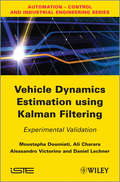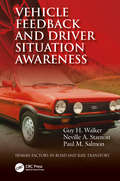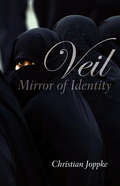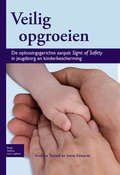- Table View
- List View
Veblen (Routledge Studies In The History Of Economics Ser. #115)
by Charles CamicA bold new biography of the thinker who demolished accepted economic theories in order to expose how people of economic and social privilege plunder their wealth from society’s productive men and women.Thorstein Veblen was one of America’s most penetrating analysts of modern capitalist society. But he was not, as is widely assumed, an outsider to the social world he acidly described. Veblen overturns the long-accepted view that Veblen’s ideas, including his insights about conspicuous consumption and the leisure class, derived from his position as a social outsider.In the hinterlands of America’s Midwest, Veblen’s schooling coincided with the late nineteenth-century revolution in higher education that occurred under the patronage of the titans of the new industrial age. The resulting educational opportunities carried Veblen from local Carleton College to centers of scholarship at Johns Hopkins, Yale, Cornell, and the University of Chicago, where he studied with leading philosophers, historians, and economists. Afterward, he joined the nation’s academic elite as a professional economist, producing his seminal books The Theory of the Leisure Class and The Theory of Business Enterprise. Until late in his career, Veblen was, Charles Camic argues, the consummate academic insider, engaged in debates about wealth distribution raging in the field of economics.Veblen demonstrates how Veblen’s education and subsequent involvement in those debates gave rise to his original ideas about the social institutions that enable wealthy Americans—a swarm of economically unproductive “parasites”—to amass vast fortunes on the backs of productive men and women. Today, when great wealth inequalities again command national attention, Camic helps us understand the historical roots and continuing reach of Veblen’s searing analysis of this “sclerosis of the American soul.”
Veblen's Century: A Collective Portrait
by Irving HorowitzThorstein Veblen has a place of honor reserved for truly important figures. Economist, iconoclast, social critic, and moral judge of the American way of life, he has continued to attract the attention of students and scholars alike. People from every spectrum of political thought and every branch of the social sciences have been drawn to his work-sometimes in praise, other times in criticism, but always with a sense of measuring what Veblen said and often how he said it.Veblen was, in the final analysis, an anthropologist of America as an advanced culture, as much a figure of the young twentieth century of America triumphant, as Tocqueville was a figure of the young nineteenth century of America ascending. We share with Veblen a sense of the observer peering at the complex foundation of behavior, whether such behavior is defined in terms of attitudes toward work and leisure, wealth and poverty, and finally, global war and peace.An examination of the contributors to the Veblen literature in this masterful volume serves to make clear just how vital Veblen was and remains to our cultural landscape. Whether the reader selects from or reads all of the statements by David Riesman, Douglas Dowd, Max Lerner, E. Digby Baltzell, Wesley Clair Mitchell, C. Wright Mills, Daniel Bell, and the other outstanding participants in Veblen's Century, the pulsating vitality of Veblen himself is well captured. Indeed, a little bit of Veblen is encapsulated in and by his commentators.Veblen's Century originated as a project initiated in 1974 by Professor Horowitz to reissue the entire corpus of Veblen's writings in new editions with introductions written expressly with this larger purpose of bringing the master of economic theory to the attention of a new generation. That the project took more than a quarter century to complete is indicative of the care with which each new essay is crafted. In addition, with Transaction being identified as the home of Veblen, books on him were offered to
Veblen's Century: A Collective Portrait
by Irving Louis HorowitzThorstein Veblen has a place of honor reserved for truly important figures. Economist, iconoclast, social critic, and moral judge of the American way of life, he has continued to attract the attention of students and scholars alike. People from every spectrum of political thought and every branch of the social sciences have been drawn to his work-sometimes in praise, other times in criticism, but always with a sense of measuring what Veblen said and often how he said it.Veblen was, in the final analysis, an anthropologist of America as an advanced culture, as much a figure of the young twentieth century of America triumphant, as Tocqueville was a figure of the young nineteenth century of America ascending. We share with Veblen a sense of the observer peering at the complex foundation of behavior, whether such behavior is defined in terms of attitudes toward work and leisure, wealth and poverty, and finally, global war and peace.An examination of the contributors to the Veblen literature in this masterful volume serves to make clear just how vital Veblen was and remains to our cultural landscape. Whether the reader selects from or reads all of the statements by David Riesman, Douglas Dowd, Max Lerner, E. Digby Baltzell, Wesley Clair Mitchell, C. Wright Mills, Daniel Bell, and the other outstanding participants in Veblen's Century, the pulsating vitality of Veblen himself is well captured. Indeed, a little bit of Veblen is encapsulated in and by his commentators.Veblen's Century originated as a project initiated in 1974 by Professor Horowitz to reissue the entire corpus of Veblen's writings in new editions with introductions written expressly with this larger purpose of bringing the master of economic theory to the attention of a new generation. That the project took more than a quarter century to complete is indicative of the care with which each new essay is crafted. In addition, with Transaction being identified as the home of Veblen, books on him were offered to
Vegan Life: Cruelty-Free Food, Fashion, Beauty and Home
by Jo PetersThere’s more to being vegan than eating your greens…A plant-based diet is the foundation of a vegan lifestyle, but you can do so much more to incorporate a cruelty-free approach into everyday life. Vegan Life highlights the simple, achievable ways you can show kindness to animals – and to the environment – not just with your choice of food but with the household products, clothing and cosmetics you buy too. With tips on how to reliably spot vegan goods when shopping, DIY ideas for making your own organic cosmetic and cleaning products and, of course, essential recipes for delicious vegan food, this book makes it easy to live more ethically.
Vegetation and Soils: A World Picture
by S. R. EyreVegetation and Soils is an introduction to the study of vegetation and soil distribution. In this accessible work, S. R. Eyre describes the distributions of these two important elements in the landscape. The book progresses regionally, and the land areas of the earth are subdivided according to the distribution of their main vegetation and soil types. The author argues that the nature of the soil is not determined by vegetation any more than it is determined by climate, but the nature of the vegetation always has some bearing on the nature of the soil, and vice versa.Eyre studies the ways in which plant communities and soil profiles develop and the complexity of the vegetation-climatic relationship. The middle and high latitudes are examined, as well as the tropical regions. In order to avoid broad generalizations of vast regions, the example of the British Isles is used to show that vegetation and soil maps can be misleading on a continental scale. The book concludes with a series of vegetation maps, which show the distribution of plant formations. Also included are tables providing climatic correlations with vegetation and a glossary of relevant terms.This classic work shows the intimate connection between vegetation development and soil development. For this reason, this book is a major contribution to the study of the physical aspects of geography and will be of particular interest to students of geography, botany, and agriculture.
Vegetation and Soils: A World Picture
by S. R. EyreVegetation and Soils is an introduction to the study of vegetation and soil distribution. In this accessible work, S. R. Eyre describes the distributions of these two important elements in the landscape. The book progresses regionally, and the land areas of the earth are subdivided according to the distribution of their main vegetation and soil types. The author argues that the nature of the soil is not determined by vegetation any more than it is determined by climate, but the nature of the vegetation always has some bearing on the nature of the soil, and vice versa.Eyre studies the ways in which plant communities and soil profiles develop and the complexity of the vegetation-climatic relationship. The middle and high latitudes are examined, as well as the tropical regions. In order to avoid broad generalizations of vast regions, the example of the British Isles is used to show that vegetation and soil maps can be misleading on a continental scale. The book concludes with a series of vegetation maps, which show the distribution of plant formations. Also included are tables providing climatic correlations with vegetation and a glossary of relevant terms.This classic work shows the intimate connection between vegetation development and soil development. For this reason, this book is a major contribution to the study of the physical aspects of geography and will be of particular interest to students of geography, botany, and agriculture.
Vehicle Dynamics Estimation using Kalman Filtering: Experimental Validation (Iste Ser. #722)
by Moustapha Doumiati Ali Charara Alessandro Victorino Daniel LechnerVehicle dynamics and stability have been of considerable interest for a number of years. The obvious dilemma is that people naturally desire to drive faster and faster yet expect their vehicles to be “infinitely” stable and safe during all normal and emergency maneuvers. For the most part, people pay little attention to the limited handling potential of their vehicles until some unusual behavior is observed that often results in accidents and even fatalities. This book presents several model-based estimation methods which involve information from current potential-integrable sensors. Improving vehicle control and stabilization is possible when vehicle dynamic variables are known. The fundamental problem is that some essential variables related to tire/road friction are difficult to measure because of technical and economical reasons. Therefore, these data must be estimated. It is against this background, that this book’s objective is to develop estimators in order to estimate the vehicle’s load transfer, the sideslip angle, and the vertical and lateral tire/road forces using a roll model. The proposed estimation processes are based on the state observer (Kalman filtering) theory and the dynamic response of a vehicle instrumented with standard sensors. These estimators are able to work in real time in normal and critical driving situations. Performances are tested using an experimental car in real driving situations. This is exactly the focus of this book, providing students, technicians and engineers from the automobile field with a theoretical basis and some practical algorithms useful for estimating vehicle dynamics in real-time during vehicle motion.
Vehicle Dynamics Estimation using Kalman Filtering: Experimental Validation
by Moustapha Doumiati Ali Charara Alessandro Victorino Daniel LechnerVehicle dynamics and stability have been of considerable interest for a number of years. The obvious dilemma is that people naturally desire to drive faster and faster yet expect their vehicles to be “infinitely” stable and safe during all normal and emergency maneuvers. For the most part, people pay little attention to the limited handling potential of their vehicles until some unusual behavior is observed that often results in accidents and even fatalities. This book presents several model-based estimation methods which involve information from current potential-integrable sensors. Improving vehicle control and stabilization is possible when vehicle dynamic variables are known. The fundamental problem is that some essential variables related to tire/road friction are difficult to measure because of technical and economical reasons. Therefore, these data must be estimated. It is against this background, that this book’s objective is to develop estimators in order to estimate the vehicle’s load transfer, the sideslip angle, and the vertical and lateral tire/road forces using a roll model. The proposed estimation processes are based on the state observer (Kalman filtering) theory and the dynamic response of a vehicle instrumented with standard sensors. These estimators are able to work in real time in normal and critical driving situations. Performances are tested using an experimental car in real driving situations. This is exactly the focus of this book, providing students, technicians and engineers from the automobile field with a theoretical basis and some practical algorithms useful for estimating vehicle dynamics in real-time during vehicle motion.
Vehicle Feedback and Driver Situation Awareness (Human Factors in Road and Rail Transport)
by Neville A. Stanton Guy H. Walker Paul M. SalmonA potentially troubling aspect of modern vehicle design – some would argue - is a trend for isolating the driver and reducing vehicle feedback, usually in the name of comfort and refinement but increasingly because of automation. There is little doubt cars have become more civilised over the years, yet despite this, the consequences of driver behaviour remain to a large extent anecdotal. Readers will have heard such anecdotes for themselves. They usually take the form of drivers of a certain age recalling their first cars from the 1970s or 80s, in which "doing 70 mph really felt like it". The question is whether such anecdotes actually reflect a bigger, more significant issue that could be better understood. Related questions have been explored in other domains such as aviation, where the change to ‘fly-by-wire’ did indeed bring about some occasionally serious performance issues that were not anticipated. Despite some clear parallels, automotive systems have been left relatively unstudied. The research described in this book aims to explore precisely these issues from a Human Factors perspective. This means connecting the topics of vehicle feel, vehicle dynamics, and automotive engineering with the latest research on driver situation awareness. The problem is explored experimentally from a variety of theoretical viewpoints but the outcomes are consistently practical. Here we have a promising new avenue along which the driver experience can be enhanced in novel and insightful ways. Tools and templates are provided so that engineers and designers can try different ways to boost vehicle safety, efficiency and enjoyment from a human-centered perspective. Association of American Publishers (AAP) Finalist for the 2019 PROSE Award Features Diagnosis of how vehicle feel impacts driver situation awareness, and how this could aid future vehicle designs Multi-theory approach to driver situation awareness, and how different views of this important concept give rise to different insights Comprehensive analysis of situation awareness in driving, the information requirements of drivers, and how these needs can be supported Practical descriptions of how state-of-science Human Factors methods have been applied in practice
Vehicle Feedback and Driver Situation Awareness (Human Factors in Road and Rail Transport)
by Neville A. Stanton Guy H. Walker Paul M. SalmonA potentially troubling aspect of modern vehicle design – some would argue - is a trend for isolating the driver and reducing vehicle feedback, usually in the name of comfort and refinement but increasingly because of automation. There is little doubt cars have become more civilised over the years, yet despite this, the consequences of driver behaviour remain to a large extent anecdotal. Readers will have heard such anecdotes for themselves. They usually take the form of drivers of a certain age recalling their first cars from the 1970s or 80s, in which "doing 70 mph really felt like it". The question is whether such anecdotes actually reflect a bigger, more significant issue that could be better understood. Related questions have been explored in other domains such as aviation, where the change to ‘fly-by-wire’ did indeed bring about some occasionally serious performance issues that were not anticipated. Despite some clear parallels, automotive systems have been left relatively unstudied. The research described in this book aims to explore precisely these issues from a Human Factors perspective. This means connecting the topics of vehicle feel, vehicle dynamics, and automotive engineering with the latest research on driver situation awareness. The problem is explored experimentally from a variety of theoretical viewpoints but the outcomes are consistently practical. Here we have a promising new avenue along which the driver experience can be enhanced in novel and insightful ways. Tools and templates are provided so that engineers and designers can try different ways to boost vehicle safety, efficiency and enjoyment from a human-centered perspective. Association of American Publishers (AAP) Finalist for the 2019 PROSE Award Features Diagnosis of how vehicle feel impacts driver situation awareness, and how this could aid future vehicle designs Multi-theory approach to driver situation awareness, and how different views of this important concept give rise to different insights Comprehensive analysis of situation awareness in driving, the information requirements of drivers, and how these needs can be supported Practical descriptions of how state-of-science Human Factors methods have been applied in practice
Vehicle Simulation: Perceptual Fidelity in the Design of Virtual Environments
by Alfred T. LeeThis book covers the problem of fidelity in the design of virtual environments with specific reference to the design of vehicle simulators. The default design goal has been on the physical replication of a given real-world environment and, in the case of vehicles, the specific appearance and function of vehicle components. This book discusses that perceptual, rather than physical, fidelity of a virtual environment, should be the design goal and the principal purpose is to produce human behavior. This book provides the rationale and design guidance to maximize perceptual fidelity in the development of virtual environments, and therefore maximize the costeffectiveness as well.
Vehicle Simulation: Perceptual Fidelity in the Design of Virtual Environments
by Alfred T. LeeThis book covers the problem of fidelity in the design of virtual environments with specific reference to the design of vehicle simulators. The default design goal has been on the physical replication of a given real-world environment and, in the case of vehicles, the specific appearance and function of vehicle components. This book discusses that perceptual, rather than physical, fidelity of a virtual environment, should be the design goal and the principal purpose is to produce human behavior. This book provides the rationale and design guidance to maximize perceptual fidelity in the development of virtual environments, and therefore maximize the costeffectiveness as well.
Vehicle-to-Grid: A Sociotechnical Transition Beyond Electric Mobility (Energy, Climate and the Environment)
by Lance Noel Gerardo Zarazua de Rubens Johannes Kester Benjamin K. SovacoolThis book defines and charts the barriers and future of vehicle-to-grid technology: a technology that could dramatically reduce emissions, create revenue, and accelerate the adoption of battery electric cars. This technology connects the electric power grid and the transportation system in ways that will enable electric vehicles to store renewable energy and offer valuable services to the electricity grid and its markets. To understand the complex features of this emergent technology, the authors explore the current status and prospect of vehicle-to-grid, and detail the sociotechnical barriers that may impede its fruitful deployment. The book concludes with a policy roadmap to advise decision-makers on how to optimally implement vehicle-to-grid and capture its benefits to society while attempting to avoid the impediments discussed earlier in the book.
Veil: Mirror Of Identity
by Christian JoppkeThe Islamic headscarf has become the subject of heated legal and political debate. France and Germany have legislated against it, and even the UK, long a champion of multiculturalism, has recently restricted the veil proper. Ever since home-grown Islamic terrorism struck Europe, these debates have become even more prominent, impassioned and wide-ranging, with vital global importance. In this concise and beautifully written introduction to the politics of the veil in modern societies, Christian Joppke examines why a piece of clothing could have led to such controversy. He dissects the multiple meanings of the Islamic headscarf, and explores its links with the global rise of Islam, Muslim integration, and the retreat from multiculturalism. He argues that the headscarf functions as a mirror of identity, but one in which national and liberal identities overlap, exposing the paradox that while it may be an affront to liberal values, its suppression is equally illiberal. Veil: Mirror of Identity will illuminate, challenge and provoke readers, and will make compelling reading for scholars, students and general readers alike.
Veil
by Christian JoppkeThe Islamic headscarf has become the subject of heated legal and political debate. France and Germany have legislated against it, and even the UK, long a champion of multiculturalism, has recently restricted the veil proper. Ever since home-grown Islamic terrorism struck Europe, these debates have become even more prominent, impassioned and wide-ranging, with vital global importance. In this concise and beautifully written introduction to the politics of the veil in modern societies, Christian Joppke examines why a piece of clothing could have led to such controversy. He dissects the multiple meanings of the Islamic headscarf, and explores its links with the global rise of Islam, Muslim integration, and the retreat from multiculturalism. He argues that the headscarf functions as a mirror of identity, but one in which national and liberal identities overlap, exposing the paradox that while it may be an affront to liberal values, its suppression is equally illiberal. Veil: Mirror of Identity will illuminate, challenge and provoke readers, and will make compelling reading for scholars, students and general readers alike.
The Veil in Kuwait: Gender, Fashion, Identity
by Thorsten Botz-Bornstein N. Abdullah-KhanThe Veil in Kuwait explores the complex reasons behind why women veil and how they are perceived by those that do not veil. Religion, culture, family, tradition, and fashion are all explored to provide insight into this fascinating phenomenon that has received global interest.
Veiled threats: Representing the Muslim woman in public policy discourses
by Naaz RashidAs Muslim women continue to be a focus of media-led debate, Naaz Rashid uses original scholarship and empirical research to examine how Muslim women are represented in policy discourse and how the trope of the Muslim woman is situated within national debates about Britishness, the death of multiculturalism and global concerns over international terrorism. Analysing the relevance of class, citizenship status, and regional differences, Veiled threats is a valuable addition to the burgeoning literature on Muslims in the UK post 9/11. It will be of interest to academics and students in public and social policy, race equality, gender, and faith-based policy.
Veiled threats: Representing the Muslim woman in public policy discourses
by Naaz RashidAs Muslim women continue to be a focus of media-led debate, Naaz Rashid uses original scholarship and empirical research to examine how Muslim women are represented in policy discourse and how the trope of the Muslim woman is situated within national debates about Britishness, the death of multiculturalism and global concerns over international terrorism. Analysing the relevance of class, citizenship status, and regional differences, Veiled threats is a valuable addition to the burgeoning literature on Muslims in the UK post 9/11. It will be of interest to academics and students in public and social policy, race equality, gender, and faith-based policy.
Veilig opgroeien: De oplossingsgerichte aanpak Signs of Safety in jeugdzorg en kinderbescherming
by Andrew Turnell Steve EdwardsIn Veilig opgroeien (oorspronkelijke titel Signs of Safety), wordt een nieuwe benadering in de bescherming van kinderen gepresenteerd. Hulpverleners in de jeugdzorg en kinderbescherming kunnen hiermee potentieel risicovolle situaties beoordelen en vinden hierin praktische hands-on strategieën voor het opbouwen van een samenwerkingrelatie met de ouders. Uit de praktijk blijkt dat dit op de lange termijn kindermishandeling en uit huis plaatsing kan voorkomen.Er zijn weinig beroepsgroepen waarbij emotie zo'n grote rol speelt als bij hulpverleners in de jeugdzorg en de kinderbescherming. Logisch; het gaat immers om kwetsbare kinderen die bedreigd worden in hun ontwikkeling, of erger. Daarom heeft ook iedereen een oordeel over het werk van deze hulpverleners. Zij liggen vaak onder vuur: omdat ze wél ingrijpen of omdat ze níet ingrijpen. Het gevolg is dat hulpverleners steeds vaker risicomijdend gedrag vertonen - het beruchte Savanna-effect - dat tot meer uithuisplaatsingen van kinderen leidt.De auteurs van Veilig opgroeien bieden een beter alternatief. Zij hebben in de praktijk vastgesteld dat samenwerking met het gezin de beste resultaten oplevert. In negen hoofdstukken worden zowel het theoretische kader als de praktijkelementen van Signs of Safety uitgebreid behandeld. Dit praktijkboek laat zien hoe je deze benadering steeds kunt toepassen: van intake via onderzoek en beoordeling tot afsluiting van het dossier.
Velvet Barrios: Popular Culture and Chicana/o Sexualities (New Directions in Latino American Cultures)
by Alicia Gasper De AlbaIn Chicana/o popular culture, nothing signifies the working class, highly-layered, textured, and metaphoric sensibility known as "rasquache aesthetic" more than black velvet art. The essays in this volume examine that aesthetic by looking at icons, heroes, cultural myths, popular rituals, and border issues as they are expressed in a variety of ways. The contributors dialectically engage methods of popular cultural studies with discourses of gender, sexuality, identity politics, representation, and cultural production. In addition to a hagiography of "locas santas," the book includes studies of the sexual politics of early Chicana activists in the Chicano youth movement, the representation of Latina bodies in popular magazines, the stereotypical renderings of recipe books and calendar art, the ritual performance of Mexican femaleness in the quinceañera, and mediums through which Chicano masculinity is measured.
Venezuela, ALBA, and the Limits of Postneoliberal Regionalism in Latin America and the Caribbean (Studies of the Americas)
by Asa K. CusackThis book provides a comprehensive analysis of the implementation, functioning, and impact of the Bolivarian Alliance for the Peoples of Our America (ALBA), cornerstone of Venezuelan foreign policy and standard-bearer of “postneoliberal” regionalism during the “Left Turn” in Latin America and the Caribbean (1998-2016). It reveals that cooperation via ALBA’s regionalised social missions, state multinationals, development bank, People’s Trade Agreement, SUCRE virtual currency, and Petrocaribe soft-loan scheme has often been hampered by complexity and conflict between the national political economies of Ecuador, Dominica, St Vincent and the Grenadines, Antigua and Barbuda, and especially Venezuela. Shared commitments to endogenous development, autonomy within mutlipolarity, and novel sources of legitimacy are undermined by serious deficiencies in control and accountability, which stem largely from the defining influence of Venezuela’s dysfunctional economy and governance. This dual dependency on Venezuela leaves the future of ALBA hanging in the balance.
Venice: A Contested Bohemia in Los Angeles
by Andrew DeenerNestled between Santa Monica and Marina del Rey, Venice is a Los Angeles community filled with apparent contradictions. There, people of various races and classes live side by side, a population of astounding diversity bound together by geographic proximity. From street to street, and from block to block, million dollar homes stand near housing projects and homeless encampments; and upscale boutiques are just a short walk from the (in)famous Venice Beach where artists and carnival performers practice their crafts opposite cafés and ragtag tourist shops. In Venice: A Contested Bohemia in Los Angeles, Andrew Deener invites the reader on an ethnographic tour of this legendary California beach community and the people who live there. In writing this book, the ethnographer became an insider; Deener lived as a resident of Venice for close to six years. Here, he brings a scholarly eye to bear on the effects of gentrification, homelessness, segregation, and immigration on this community. Through stories from five different parts of Venice—Oakwood, Rose Avenue, the Boardwalk, the Canals, and Abbot Kinney Boulevard— Deener identifies why Venice maintained its diversity for so long and the social and political factors that threaten it. Drenched in the details of Venice’s transformation, the themes and explanations will resonate far beyond this one city. Deener reveals that Venice is not a single locale, but a collection of neighborhoods, each with its own identity and conflicts—and he provides a cultural map infinitely more useful than one that merely shows streets and intersections. Deener's Venice appears on these pages fully fleshed out and populated with a stunning array of people. Though the character of any neighborhood is transient, Deener's work is indelible and this book will be studied for years to come by scholars across the social sciences.
Venice: A Contested Bohemia in Los Angeles
by Andrew DeenerNestled between Santa Monica and Marina del Rey, Venice is a Los Angeles community filled with apparent contradictions. There, people of various races and classes live side by side, a population of astounding diversity bound together by geographic proximity. From street to street, and from block to block, million dollar homes stand near housing projects and homeless encampments; and upscale boutiques are just a short walk from the (in)famous Venice Beach where artists and carnival performers practice their crafts opposite cafés and ragtag tourist shops. In Venice: A Contested Bohemia in Los Angeles, Andrew Deener invites the reader on an ethnographic tour of this legendary California beach community and the people who live there. In writing this book, the ethnographer became an insider; Deener lived as a resident of Venice for close to six years. Here, he brings a scholarly eye to bear on the effects of gentrification, homelessness, segregation, and immigration on this community. Through stories from five different parts of Venice—Oakwood, Rose Avenue, the Boardwalk, the Canals, and Abbot Kinney Boulevard— Deener identifies why Venice maintained its diversity for so long and the social and political factors that threaten it. Drenched in the details of Venice’s transformation, the themes and explanations will resonate far beyond this one city. Deener reveals that Venice is not a single locale, but a collection of neighborhoods, each with its own identity and conflicts—and he provides a cultural map infinitely more useful than one that merely shows streets and intersections. Deener's Venice appears on these pages fully fleshed out and populated with a stunning array of people. Though the character of any neighborhood is transient, Deener's work is indelible and this book will be studied for years to come by scholars across the social sciences.
Venice: A Contested Bohemia in Los Angeles
by Andrew DeenerNestled between Santa Monica and Marina del Rey, Venice is a Los Angeles community filled with apparent contradictions. There, people of various races and classes live side by side, a population of astounding diversity bound together by geographic proximity. From street to street, and from block to block, million dollar homes stand near housing projects and homeless encampments; and upscale boutiques are just a short walk from the (in)famous Venice Beach where artists and carnival performers practice their crafts opposite cafés and ragtag tourist shops. In Venice: A Contested Bohemia in Los Angeles, Andrew Deener invites the reader on an ethnographic tour of this legendary California beach community and the people who live there. In writing this book, the ethnographer became an insider; Deener lived as a resident of Venice for close to six years. Here, he brings a scholarly eye to bear on the effects of gentrification, homelessness, segregation, and immigration on this community. Through stories from five different parts of Venice—Oakwood, Rose Avenue, the Boardwalk, the Canals, and Abbot Kinney Boulevard— Deener identifies why Venice maintained its diversity for so long and the social and political factors that threaten it. Drenched in the details of Venice’s transformation, the themes and explanations will resonate far beyond this one city. Deener reveals that Venice is not a single locale, but a collection of neighborhoods, each with its own identity and conflicts—and he provides a cultural map infinitely more useful than one that merely shows streets and intersections. Deener's Venice appears on these pages fully fleshed out and populated with a stunning array of people. Though the character of any neighborhood is transient, Deener's work is indelible and this book will be studied for years to come by scholars across the social sciences.
Venice: A Contested Bohemia in Los Angeles
by Andrew DeenerNestled between Santa Monica and Marina del Rey, Venice is a Los Angeles community filled with apparent contradictions. There, people of various races and classes live side by side, a population of astounding diversity bound together by geographic proximity. From street to street, and from block to block, million dollar homes stand near housing projects and homeless encampments; and upscale boutiques are just a short walk from the (in)famous Venice Beach where artists and carnival performers practice their crafts opposite cafés and ragtag tourist shops. In Venice: A Contested Bohemia in Los Angeles, Andrew Deener invites the reader on an ethnographic tour of this legendary California beach community and the people who live there. In writing this book, the ethnographer became an insider; Deener lived as a resident of Venice for close to six years. Here, he brings a scholarly eye to bear on the effects of gentrification, homelessness, segregation, and immigration on this community. Through stories from five different parts of Venice—Oakwood, Rose Avenue, the Boardwalk, the Canals, and Abbot Kinney Boulevard— Deener identifies why Venice maintained its diversity for so long and the social and political factors that threaten it. Drenched in the details of Venice’s transformation, the themes and explanations will resonate far beyond this one city. Deener reveals that Venice is not a single locale, but a collection of neighborhoods, each with its own identity and conflicts—and he provides a cultural map infinitely more useful than one that merely shows streets and intersections. Deener's Venice appears on these pages fully fleshed out and populated with a stunning array of people. Though the character of any neighborhood is transient, Deener's work is indelible and this book will be studied for years to come by scholars across the social sciences.














